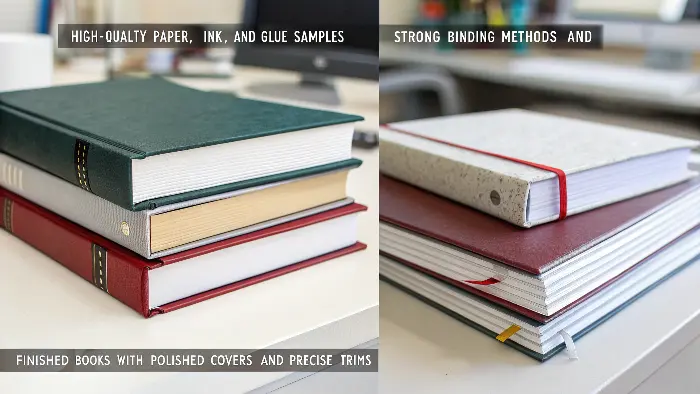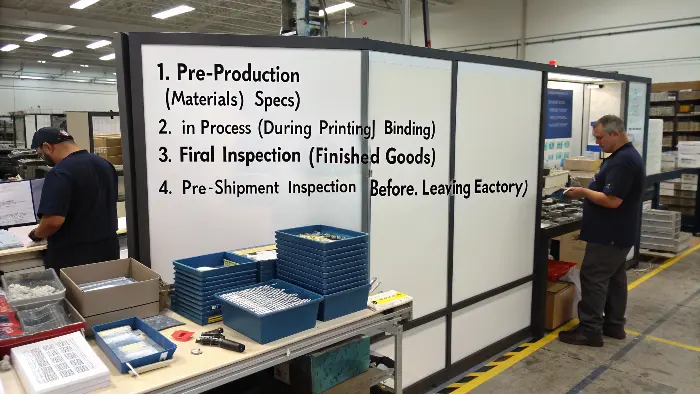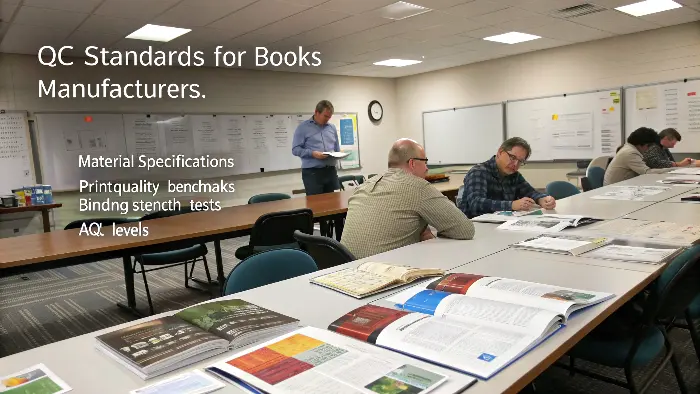Wholesalers, are you losing sleep over book quality? Poorly made books damage your brand and profits. Understanding manufacturing standards is absolutely key to your success.
Wholesalers must scrutinize book manufacturing standards, focusing on binding integrity, paper and print quality, cover durability, and compliance with safety and construction norms to ensure sellable, lasting products.
When I talk to people like Michael, our German stationery buyer, about sourcing products – whether it’s a high-end notebook from Panoffices or a batch of commercially printed books – quality is always, and I mean always, at the top of the list. It’s not just about looking good on the shelf; it’s about delivering value and building trust. So, let’s break down what "quality" really means in book manufacturing. It’s more than just a buzzword; it’s a whole system of checks and balances.
What are the quality standards for manufacturing books, really?
Ever received a shipment of books only to find they fall apart too easily? It’s frustrating and costly. Knowing the baseline manufacturing standards can save you headaches.
Book manufacturing quality standards cover material selection (paper, ink, adhesives), precise printing, robust binding methods, accurate finishing (trimming, cover application), and overall construction durability, ensuring a professional, lasting product.
Okay, so what are we really talking about when we say "quality standards" for making books? It’s not just a vague feeling that a book is "nice." It’s a set of specific, measurable benchmarks. I always think of it like the standards we uphold at Panoffices for our stationery – every detail matters, from the paper in our notebooks to the mechanism in our pens. For books, these standards touch every part of the production journey.
Key Pillars of Book Manufacturing Standards
| Aspect | Description | Why It Matters for Wholesalers |
|---|---|---|
| Material Specs | Paper weight, type, opacity; ink quality; adhesive strength. | Affects look, feel, readability, durability. |
| Print Precision | Image sharpness, color accuracy, registration, no smudges. | Directly impacts visual appeal. |
| Binding Integrity | Method suitability (e.g., perfect, sewn), spine strength, page adhesion. | Crucial for longevity and use. |
| Finishing Accuracy | Even trimming, squareness, proper cover fit, lamination. | Defines professional appearance. |
Imagine Michael receiving a sample of a new book line. He’d be looking at all these things. Does the print look sharp? Does the binding feel solid? These aren’t just nice-to-haves; they are fundamental quality indicators. Good manufacturers will have internal standards for all these, and often, they’ll align with broader industry expectations. It’s about ensuring that the final product isn’t just a collection of pages, but a well-crafted item. Honestly, skimping here is just asking for trouble down the line – returns, unhappy customers, and a damaged reputation. Not worth it!
What are four different elements of quality standards in book production?
Pinpointing quality can feel overwhelming with so many details. What specific elements truly define a well-made book for wholesalers? Let’s break it down clearly.
Four crucial elements of book quality standards are: 1. Material Quality (paper, ink, glue), 2. Print and Image Fidelity, 3. Binding Strength and Type, and 4. Finishing and Presentation (cover, trim).

Alright, let’s get more specific. When I look at a new Panoffices notebook, I break down its quality. Michael, our German buyer, does the same with stationery. For books, focus on these four big areas.
The Core Four: Elements of Book Quality
- Material Quality – The Foundation:
- This includes the paper (its weight, how see-through it is), ink (consistent color, doesn’t smudge), and glue (strong, flexible). Imagine a children’s book – it needs tough paper, right? Bad materials mean a bad book, period. We’re picky about paper in our Panoffices notebooks for this reason!
- Print and Image Fidelity – The Visuals:
- Is the text sharp? Are colors right and even? Are pictures clear? Blurry text or weird colors? That’s a red flag. Readers notice this stuff immediately.
- Binding Strength and Type – The Backbone:
- Is it glued (perfect bound) or sewn? The binding must fit the book type and be strong. Pages falling out? No way! Hardcovers need strong covers too. A book breaking apart is a disaster.
- Finishing and Presentation – The First Impression:
- Are the edges trimmed neatly? Is the cover on straight and creased well? Any special coatings (lamination) smooth? A messy finish makes any book look cheap. It’s the first thing people see!
These four are your main checklist. If a book scores well here, it’s probably good quality. One slip-up in these areas can really hurt the book’s appeal and how happy your customers are. It’s about getting all these details right, every time. 🔥What are the 4 types of quality control every book wholesaler should know?
Just hoping for good quality isn’t a strategy. What actual checks and balances should be in place during book manufacturing? Understanding QC types is vital.
- Are the edges trimmed neatly? Is the cover on straight and creased well? Any special coatings (lamination) smooth? A messy finish makes any book look cheap. It’s the first thing people see!
The four key types of quality control in book manufacturing are: 1. Pre-production (materials/specs), 2. In-process (during printing/binding), 3. Final inspection (finished goods), and 4. Pre-shipment inspection (before leaving factory).

So, we know what to look for. But when should these checks happen? Good quality control is a system, not just a final glance. At Panoffices, we check throughout production. It’s vital. For books, there are roughly four key QC stages.
Key QC Stages in Book Manufacturing
| QC Type | When It Happens | Key Checks | Why It Matters for You |
|---|---|---|---|
| 1. Pre-Production | Before mass production | Materials (paper, ink), proofs, files. | Catches issues early, saving money and time. Ensures basics. |
| 2. In-Process (IPQC) | During printing & binding | Print quality, folding, gluing/sewing. | Allows real-time fixes. Prevents many defects. |
| 3. Final Product | After books are made | Random sampling for all agreed standards (binding, trim, print). | Confirms batch quality before packing. Last internal check. |
| 4. Pre-Shipment (PSI) | When packed, before dispatch | Quantity, packaging, labels, random check of packed items. | Ensures correct, well-packed order. Michael needs this for Panoffices goods. |
Imagine finding a major paper flaw before printing 10,000 books – that’s a huge save! Spotting a binding error early prevents thousands of bad books. Michael, our buyer, expects suppliers like us to have robust checks. For wholesalers, knowing these stages helps you ask manufacturers the right questions. Do they have a thorough system, or just a quick check at the end? This massively impacts the consistency of your books. It’s about preventing problems, not just finding them later. So important!
So, what are the QC standards wholesalers must demand for books?
Knowing about quality is one thing, but what specific QC standards should you actually insist on from your book manufacturers? This is where you take control.
Wholesalers must demand clear QC standards including: adherence to agreed material specifications, print quality benchmarks (e.g., color targets, defect limits), binding strength tests, and strict AQL (Acceptable Quality Limit) levels.

Okay, this is crucial. Knowing about quality is one thing; actually demanding specific standards from your book makers is another. You’ve got to be clear. When we at Panoffices work with pros like Michael, we lay out all expectations right at the start. It’s just how you do good business.
QC Standards You MUST Demand:
- Detailed Material Specs:
- Don’t just ask for "good paper." Specify its weight (GSM), brightness, and how see-through it is (opacity). Same for cover stock.
- Why? Vagueness lets the factory choose, and it might not be what you need.
- Clear Print Quality Targets:
- Provide color codes (e.g., Pantone) or approved samples. Define limits for print mistakes like smudges or misaligned colors.
- Why? "Looks good" isn’t enough. You need real targets.
- Binding Strength & Construction Tests:
- Ask for tests like page pull-strength (how hard to yank a page out?) or spine flexibility.
- Why? These tests check if the book will actually last, not just look pretty.
- Acceptable Quality Limits (AQLs):
- This is an industry way to check batches. You agree on how many minor, major, or critical defects are okay. Missing pages? That’s a critical defect, so AQL would be 0!
- Why? AQL gives you a clear, fair system to judge the whole shipment.
- Solid Packaging Standards:
- Specify how books must be boxed and palletized to prevent damage. Think strong cartons, moisture protection. Michael relies on good packaging for his international orders from us.
By insisting on these, you build a real framework for quality. It’s not about being annoying; it’s about making sure you get the product you’re paying for, and one your customers will be happy with. Being upfront like this saves a world of pain later. Seriously!Conclusion
Ensuring top book quality means checking materials, print, binding, and finish. Demanding clear standards protects your investment and delights your customers. Panoffices knows quality matters.
- Specify how books must be boxed and palletized to prevent damage. Think strong cartons, moisture protection. Michael relies on good packaging for his international orders from us.

